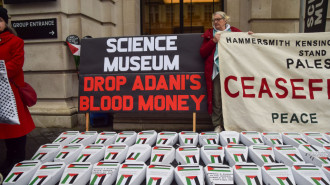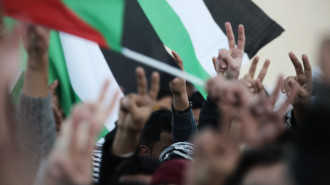
Art Design Lebanon is fusing art and history at the ancient mountain monastery of Deir al Kalaa

The site of a millennia-old temple might seem like an unusual place to discover modern art. High in the mountains of Lebanon, the ancient monastery of Deir al Kalaa in Beit Meri has brought together works by a multidisciplinary team of collaborating artists and designers to create Lost In The Right Direction, the latest exhibition from Art Design Lebanon (AD Leb).
Founded in 2021, AD Leb is a cultural platform created by Lebanese gallerist Annie Vartivarian. Originally conceived by designer Gaïa Fodoulian, her daughter, Vartivarian took on the project after Foudoulin was killed by the August 4 Beirut Port explosion back in 2020.
"We wanted the artists to have a platform here, and to attract people to come back to and discover the archaeological site. Everyone is, in a way, the guardian of his past, and when you know the importance, you can guard it better"
“It was Gaïa’s idea to have the exhibitions in places where they have character and history,” Vartivarian told The New Arab. “At the beginning, [we wanted] to make a show in an open space. It’s [taking the] heritage of Lebanon and tying it into nature.
“Each [piece] has different inspiration, either from the history [or] the landscape,” she added. “We just shine the light on it, to bring all together with our design; history; archaeology; architecture. This is the aim.”
Deir al Kalaa began as a Roman temple before the Maronite monastery of Saint John the Baptist was later constructed on the same site. The various other remains and ruins found around the site testify to generations of diverse inhabitants, demonstrating the richness of Lebanese history.
“The site is a [combination of] Roman and Byzantine sites,” explained Tania Zaven, Director of North Mount Lebanon for the Directorate General of Antiquities (DGA).
“It was an [small] industrial settlement. You have olive presses, a church, a bathhouse that was used in the Roman period and continued in the Byzantine period, and villas.”
“With all the problems that we had in Lebanon [and] the explosion, the soul of Beirut [has been] destroyed, because the soul of Beirut was the artists [and] the creative industries that are diminishing by the day,” she added. “We wanted the artists to have a platform here, and to attract people to come back to and discover the archaeological site. Everyone is, in a way, the guardian of his past, and when you know the importance, you can guard it better.”
Assisted by L’Institut Francais and the DGA, the 37 participating creatives were brought on-site and given tours by archaeology professor Assaad Seif. The resulting collection of 18 contemporary works, displayed in and around the ruins, creates a fascinating interplay between the ancient past and the present, inspired by notions of memory, history, time, migration and loss.
Fibre Artist Adrian Pepe, working with a group of Lebanese craftswomen, has created an embroidered Sky Map – inspired by the way ancient shepherds would use stars for guidance – within a curated space filled with other textile creations, all made from Awassi wool, a staple of the Levantine region for thousands of years.
“I discovered that a lot of the craft practices have been dying,” Pepe explained. “Today, there's around 1,000 tonnes of wool produced in Lebanon, and all of it is discarded because the processes related to it are no longer there. In searching [for] the last remaining artisans, we started to construct a narrative, taking the bits of information that we were gathering [and] reinserting them into the material.
“The material was so correct within this exhibition because it's all about direction,” he continued. “Finding greener pastures with this sentience – the provider that you're collaborating with – and travelling arid landscapes to sustain the animal and, as a result, yourself; the contrast between this nomadic material and these big rocks that form the settlements is quite interesting.”
In contrast, Future Was A Year Ago – a collaborative work between architect and designer Roula Salamoun and visual artist Ieva Saudargaitė Douaihi – explores the notion of the copy and replications versus originality that bridges both the physical and in the digital worlds.
“The first time we went to the site, one thing that really caught our attention was all these really bright coloured stones, which are marvellous in the array of colours they have,” said Roula.
“We borrowed a stone from the site – with the approval of the DGA – and we recreated it with [resin], using these colours that we saw, and that inspired us. We then took a photo of the copy, in situ, [and] using photogrammetry, we created a 3-D object, which we will be dropping as an NFT.
“I think Lebanon – and Beirut in particular – was really a centre for design for the past years,” she added. “I think that this shifted with the economic collapse and the revolution and so on. I think showing that there's still a striving culture of art and design is really important," Roula concluded.
Visual artist Nathaniel Rackowe produced the sculptural, abstract piece Drop By Drop, influenced by Fodoulian’s preparatory drawings for a work emulating the stalactites and stalagmites of Lebanon’s famous Jeita Grotto, realised in stainless steel beams tipped with miniature lights, pointing to a hopeful future.
“They're her designs, but they were not produced before,” said Vartivarian. “I wanted to give importance not only [to the designers]. They cannot do their work if there are no artisans. I also wanted to give importance to these people and the work they do, finishing the works of designers. So I asked [Rackowe] to do the cover of collaboration with Gaïa’s design.”
As part of the exhibition, heritage non-profit Silat For Culture will take visitors on guided tours of Deir al Kalaa.
Wirework installations have been added to illustrate the missing pillars, revealing the original layout of the Byzantine church, while standout features – such as a Roman olive oil press and the bathhouse ruins – have been partially refurbished with new wooden elements better represent how they would have been when they were still in use.
Robert McKelvey is a British freelance journalist and culture writer based in Lebanon.
Follow him on Twitter: @RCMcKelvey





